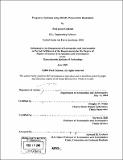Frequency synthesis using MEMS piezoelectric resonators
Author(s)
Calhoun, Paul Jacob, 1979-
DownloadFull printable version (6.051Mb)
Alternative title
Frequency synthesis using microelectromechanical systems piezoelectric resonators
Other Contributors
Massachusetts Institute of Technology. Dept. of Aeronautics and Astronautics.
Advisor
Douglas W. White and Steven R. Hall.
Terms of use
Metadata
Show full item recordAbstract
(cont.) Ultimately, this thesis presents two approaches to frequency synthesizer design. The first uses frequency windows of approximately 200 MHz. The 800 MHz to 1 GHz matching network is presented in detail along with predicted performance capabilities across this frequency range. The second design implements matching networks with variable capacitors and a variable load impedance. CAD performance simulations validate the broadband switched array design concept, and represent a first step towards realizing a new, commercially viable RF MEMS oscillator and switched array frequency synthesizer. The views expressed in this article are those of the author and do not reflect the official policy or position of the United States Air Force, Department of Defense, or the U.S. Government. This thesis explores the foundational issues in oscillator and frequency synthesizer design using an integrated MEMS piezoelectric resonator. It presents an original low phase-noise oscillator design and two frequency synthesizer designs using the emerging technology of Draper Laboratory's MEMS GHz-range resonator. The designs leverage the extremely small size and high Q of this MEMS resonator to develop integrable, energy efficient, low phase noise oscillators and frequency synthesizers. The circuits presented offer significant size and flexibility advantages over present designs, while promising exceptional performance. First, a 1 GHz frequency oscillator design is described incorporating the longitudinal mode bar (L-Bar) resonator with a SiGe bipolar junction transistor (BJT) in a one-port reflection topology. This design choice was made to minimize circuit complexity when later employed in a frequency synthesizer with a broadband array of switched resonators. Harmonic frequency matching is considered in a trade study between phase noise, efficiency, and circuit complexity. Performance was further enhanced using a novel approach for selecting the target static negative impedance looking into the transistor. This method modifies the transistor base current and matching networks in a manner that allows simultaneous optimization of phase noise and efficiency. The resulting oscillator has size and predicted performance characteristics that are unachievable using present technology. Second, the matching networks from the 1 GHz oscillator are altered to allow for oscillation over a frequency range selected by an array of switched resonators. The resulting frequency synthesizer is designed to operate in the range of 200 MHz to 1 GHz.
Description
Thesis (S.M.)--Massachusetts Institute of Technology, Dept. of Aeronautics and Astronautics, 2004. Includes bibliographical references (p. 79).
Date issued
2004Department
Massachusetts Institute of Technology. Department of Aeronautics and AstronauticsPublisher
Massachusetts Institute of Technology
Keywords
Aeronautics and Astronautics.